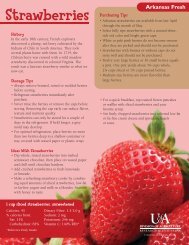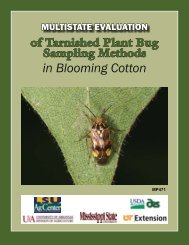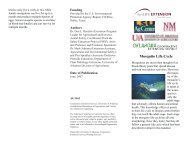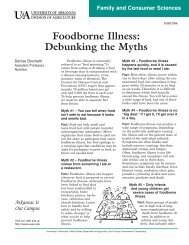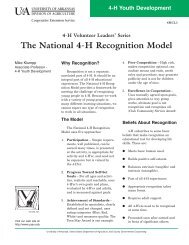Evergreen Hedge Or Screen Plants - University of Arkansas ...
Evergreen Hedge Or Screen Plants - University of Arkansas ...
Evergreen Hedge Or Screen Plants - University of Arkansas ...
Create successful ePaper yourself
Turn your PDF publications into a flip-book with our unique Google optimized e-Paper software.
Osmanthus<br />
Certainly this genus is a worthy suggestion for a great hedge or screen plant, even though most species<br />
tend to be a bit more rounded and much slower‐ growing than redtip photinia. Osmanthus are known for<br />
extremely fragrant flowers. The Osmanthus seem to get no respect because they are easily confused with<br />
other genera. The little‐used Devilwood (O. americanus) could fool many as a privet (Ligustrum) since the<br />
leaf margin lacks serration. Others like O. xfortunei (Fortune’s osmanthus; O. heterophyllus x O. fragrans)<br />
and O. heterophyllus (Holly osmanthus) look like hollies because <strong>of</strong> the serrated leaf margins. There is an easy<br />
way to distinguish Osmanthus from hollies: leaf arrangement on Osmanthus is opposite and alternate to Ilex.<br />
Osmanthus xfortunei<br />
Photinia serrulata – Chinese Photinia<br />
This is actually one <strong>of</strong> the parents <strong>of</strong> the redtip hybrid. This plant is seen all over central and south<br />
<strong>Arkansas</strong>, but it is restricted to older landscapes. It is suggested that when redtip hit the market in the late<br />
’50s, people stopped purchasing the larger Chinese photinia. Chinese photinia is clearly a much larger<br />
(20 feet tall by 20 feet wide) and more rounded plant than redtip. A number <strong>of</strong> people will show disfavor<br />
for this plant since the flowers have an unpleasant odor. The flower display is exceptional in late<br />
March/early April followed by a nice display <strong>of</strong> dull red fruits borne in large clusters. Emerging foliage is<br />
more <strong>of</strong> a muted red in contrast to the striking red <strong>of</strong> redtip. Leaf spot fungus is not as serious on this plant.<br />
This species may be difficult to find in the retail trade. The Japanese photinia (P. glabra) would also be a<br />
good plant to consider but may be just as susceptible to leaf spot as redtip.<br />
Chinese photinia<br />
15









